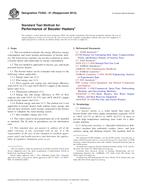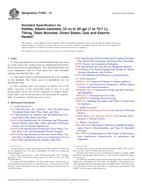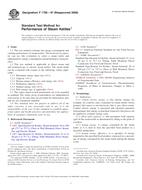Wir benötigen Ihre Einwilligung zur Verwendung der einzelnen Daten, damit Sie unter anderem Informationen zu Ihren Interessen einsehen können. Klicken Sie auf "OK", um Ihre Zustimmung zu erteilen.
ASTM F2022-01(2013)
Standard Test Method for Performance of Booster Heaters
Automatische name übersetzung:
Standard Test Method for Performance Booster Heizungen
NORM herausgegeben am 1.6.2013
Informationen über die Norm:
Bezeichnung normen: ASTM F2022-01(2013)
Anmerkung: UNGÜLTIG
Ausgabedatum normen: 1.6.2013
SKU: NS-52477
Zahl der Seiten: 12
Gewicht ca.: 36 g (0.08 Pfund)
Land: Amerikanische technische Norm
Kategorie: Technische Normen ASTM
Kategorie - ähnliche Normen:
Die Annotation des Normtextes ASTM F2022-01(2013) :
Keywords:
booster, booster heater, capacity, dishwasher, dishwasher machine, efficiency, energy, performance, test method, water heater, ICS Number Code 91.140.65 (Water heating equipment)
Ergänzende Informationen
| Significance and Use | ||||||
|
5.1 The energy input rate test is used to confirm that the booster heater is operating properly prior to further testing. 5.2 Booster heater flow capacity is an indicator of the booster heater's ability to supply hot water for sanitation. The booster heater's flow capacity can be used by the operator to determine the appropriate size booster heater for their operation. Booster heater energy rate is an indicator of the booster heater's energy consumption during continuous water flow. The energy rate can be used by food service operators to estimate the energy consumption of the booster heater. Booster heater energy efficiency is a precise indicator of a booster heater's energy performance during the continuous flow test. This information enables the food service operator to consider energy performance when selecting a booster heater. 5.3 Booster heater flow capacity at 50 % of the maximum capacity is an indicator of the booster heater's ability to provide hot water for sanitation at this reduce flow rate condition. Booster heater energy efficiency at a flow rate of 50 % of maximum capacity is an indicator of a booster heater's energy performance at this flow rate. The booster heater outlet temperature during the capacity test at a flow rate of 50 % of maximum capacity is an indicator of the booster heater's temperature response at this reduced flow rate. 5.4 Preheat energy and time can be useful to food service operators to manage power demands and to know how quickly the booster heater can be ready for operation. 5.5 Idle energy rate and pilot energy rate can be used to estimate energy consumption during standby periods. |
||||||
| 1. Scope | ||||||
|
1.1 This test method evaluates the energy efficiency, energy consumption and water heating performance of booster heaters. The food service operator can use this evaluation to select a booster heater and understand its energy consumption. 1.2 This test method is applicable to electric, gas, and steam powered booster heaters. 1.3 The booster heater can be evaluated with respect to the following (where applicable): 1.3.1 Energy input rate (1.3.2 Pilot energy rate (1.3.3 Flow capacity rate, energy rate, and energy efficiency with 110°F (43.3°C) and 140°F (60.0°C) supply to the booster heater inlet (9.4). 1.3.4 Thermostat calibration (1.3.5 Energy rate and energy efficiency at 50% of flow capacity rate with 110°F (43.3°C) and 140°F (60.0°C) supply to the booster heater inlet (9.6). 1.3.6 Preheat energy and time (1.3.7 Idle (standby) energy rate (1.4 The values stated in inch-pound units are to be regarded as standard. The SI units in parentheses are for information only. 1.5 This standard does not purport to address all of the safety concerns, if any, associated with its use. It is the responsibility of the user of this standard to establish appropriate safety and health practices and determine the applicability of regulatory limitations prior to use. |
||||||
| 2. Referenced Documents | ||||||
|
Ähnliche Normen:
Historisch
1.7.2014
Historisch
1.9.2011
Historisch
1.7.2012
Historisch
1.11.2012
Historisch
1.11.2012
Historisch
1.10.2008
Empfehlungen:
Aktualisierung der technischen Normen
Wollen Sie sich sicher sein, dass Sie nur die gültigen technischen Normen verwenden?
Wir bieten Ihnen eine Lösung, die Ihnen eine Monatsübersicht über die Aktualität der von Ihnen angewandten Normen sicher stellt.
Brauchen Sie mehr Informationen? Sehen Sie sich diese Seite an.



 ASTM D6665-09(2014)..
ASTM D6665-09(2014).. ASTM E1998-11
ASTM E1998-11 ASTM F1376-92(2012)..
ASTM F1376-92(2012).. ASTM F1602-12
ASTM F1602-12 ASTM F1603-12
ASTM F1603-12 ASTM F1785-97(2008)..
ASTM F1785-97(2008)..
 Cookies
Cookies
